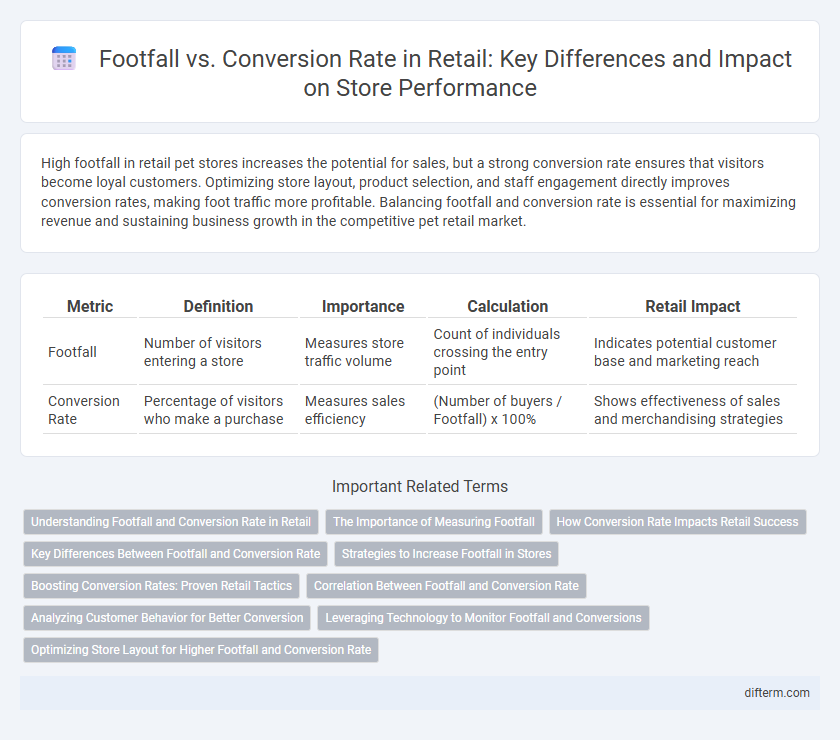High footfall in retail pet stores increases the potential for sales, but a strong conversion rate ensures that visitors become loyal customers. Optimizing store layout, product selection, and staff engagement directly improves conversion rates, making foot traffic more profitable. Balancing footfall and conversion rate is essential for maximizing revenue and sustaining business growth in the competitive pet retail market.
Table of Comparison
| Metric | Definition | Importance | Calculation | Retail Impact |
|---|---|---|---|---|
| Footfall | Number of visitors entering a store | Measures store traffic volume | Count of individuals crossing the entry point | Indicates potential customer base and marketing reach |
| Conversion Rate | Percentage of visitors who make a purchase | Measures sales efficiency | (Number of buyers / Footfall) x 100% | Shows effectiveness of sales and merchandising strategies |
Understanding Footfall and Conversion Rate in Retail
Footfall represents the total number of customers entering a retail store, serving as a key metric for measuring store traffic and potential sales opportunities. Conversion rate indicates the percentage of these visitors who make a purchase, directly reflecting the effectiveness of sales strategies and customer engagement within the store. Analyzing both footfall and conversion rate provides critical insights into store performance, enabling retailers to optimize marketing efforts and store layout to boost profitability.
The Importance of Measuring Footfall
Measuring footfall in retail provides critical insight into the volume of potential customers entering a store, serving as the foundation for analyzing conversion rates. Accurate footfall data enables retailers to evaluate store performance, optimize staffing levels, and tailor marketing strategies to increase customer engagement and sales. By understanding footfall patterns, businesses can identify peak hours, improve customer flow, and ultimately boost the conversion rate from visitors to actual buyers.
How Conversion Rate Impacts Retail Success
Conversion rate directly influences retail success by determining the percentage of footfall that results in sales, turning mere visitors into paying customers. A higher conversion rate signifies effective product placement, staff engagement, and promotional strategies, ultimately boosting revenue and profitability. Retailers optimize conversion rates by enhancing the in-store experience, tailoring marketing efforts, and analyzing customer behavior to meet demand precisely.
Key Differences Between Footfall and Conversion Rate
Footfall measures the total number of customers entering a retail store, reflecting general traffic volume, while conversion rate calculates the percentage of those visitors who complete a purchase, indicating sales efficiency. Footfall is a quantitative metric essential for assessing store popularity, whereas conversion rate is a qualitative indicator that reveals the effectiveness of merchandising, staff engagement, and overall customer experience. Understanding these key differences helps retailers identify whether to improve marketing strategies to boost visitor numbers or enhance in-store tactics to increase sales from existing traffic.
Strategies to Increase Footfall in Stores
Increasing footfall in retail stores relies on targeted marketing campaigns, such as localized promotions and engaging social media content that drive awareness and attract potential customers. Enhancing in-store experiences through interactive displays, personalized customer service, and exclusive events boosts visitor interest and encourages repeat visits. Implementing data-driven location analysis and optimizing store layouts based on consumer behavior further elevates foot traffic and supports higher conversion rates.
Boosting Conversion Rates: Proven Retail Tactics
Boosting conversion rates in retail requires analyzing footfall patterns to identify peak shopping times and optimize staff allocation. Implementing targeted in-store promotions and personalized customer engagement strategies increases purchase likelihood. Leveraging data-driven insights from foot traffic sensors and POS systems enhances product placement and marketing effectiveness, directly improving sales performance.
Correlation Between Footfall and Conversion Rate
Higher footfall in retail stores often correlates with increased sales opportunities, but it does not always guarantee a higher conversion rate; effective store layout, product availability, and staff engagement significantly influence converting visitors into buyers. Data analysis shows that while stores with high footfall can experience lower conversion rates due to crowding or poor customer experience, optimized customer journey strategies improve both metrics simultaneously. Retailers leveraging real-time footfall tracking combined with targeted promotions can maximize conversion rates by addressing shopper behavior patterns directly.
Analyzing Customer Behavior for Better Conversion
Footfall measures the number of visitors entering a retail store, while conversion rate tracks the percentage of those visitors who make a purchase. Analyzing customer behavior through footfall patterns and conversion metrics helps identify peak shopping times, popular product areas, and potential bottlenecks in the shopping experience. Retailers leveraging this data can optimize store layout, staffing, and targeted promotions to increase conversion rates and boost overall sales performance.
Leveraging Technology to Monitor Footfall and Conversions
Leveraging advanced technologies such as AI-powered analytics and IoT sensors enables retailers to accurately monitor footfall patterns and conversion rates in real time. Integrating data from video analytics and mobile tracking systems provides actionable insights to optimize store layouts and personalized marketing strategies. These technological tools enhance the understanding of customer behavior, driving higher conversion rates and maximizing retail performance.
Optimizing Store Layout for Higher Footfall and Conversion Rate
Optimizing store layout significantly enhances footfall and conversion rate by creating intuitive pathways and strategically placing high-demand products near entrances. Effective placement of promotional displays and clear signage encourages customer engagement, increasing dwell time and likelihood of purchase. Incorporating data-driven insights on customer movement patterns helps retailers arrange merchandise to maximize exposure and drive sales conversions.
Footfall vs Conversion Rate Infographic

 difterm.com
difterm.com